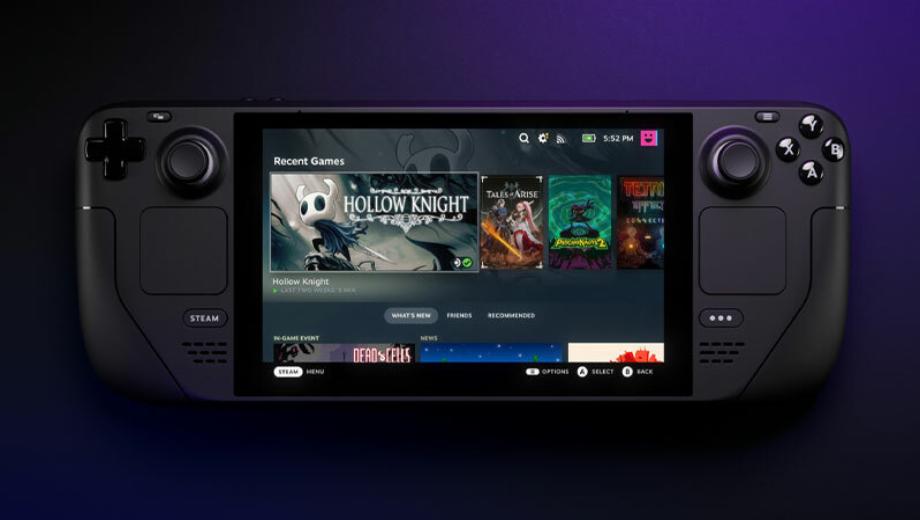ROG Ally vs. Steam Deck

PC gaming has been freed from the confines of the desktop PC and laptop, and you can now sit down and enjoy a wide range of gaming greats from the comfort of, well, anywhere really. Whether you’re sat on your sofa, a train, or even nestled into bed, devices like the Steam Deck and Asus ROG Ally let you play your favorites wherever you are.
More and more of these portable PC devices are releasing, but Valve’s Steam Deck and Asus’ ROG Ally are two of the most prominent around. Which should you buy? We took a look at the two devices so you know which is right for you.
Specs
The specs probably represent the largest gulf between these two devices. The ROG Ally is the more powerful device by far, with AMD’s Z1 series processors. Of those, you have the choice of two: The Ryzen Z1, with six Zen 4 cores and four RDNA 3 cores for 2.8 TFLOPS of theoretical performance, while the more expensive Z1 Extreme has eight Zen 4 cores, 12 RDNA 3 cores, and up to 8.6 TFLOPs of performance.
In contrast, the Steam Deck has just four Zen 2 cores and eight RDNA 2 cores, and up to 1.6 TFLOPs of performance. The Ally also goes up to 30W of power draw, while the Deck tops out at 15W. Thankfully for the Steam Deck, though, there are some similarities here too. Both have 16GB of LPDDR5 RAM, a microSD card slot, and a headphone jack.
There’s no doubt here: The ROG Ally is the more powerful of these two devices by far, and it takes this opening round.
Winner: Asus ROG Ally
Battery
Pure performance is only part of the story though, and top-tier performance is no good if the battery life isn’t up to much. You might expect the ROG Ally to fall slightly here, and it is true that, running at the top specs, the Ally’s battery won’t last as long as the Steam Deck. But turn those settings down and the Ally is able to match the Deck’s battery life while also outputting a larger resolution. Push the frame rate and resolution down and the Ally outmatches the Steam Deck.
This battery section is short, but vital, and the Ally has won it again. While you can drain it in less than an hour if you really want to, it’s capable of pushing even longer than the Steam Deck.
Winner: Asus ROG Ally
Design
While maybe not as important as the battery and performance, the design is still an important part of the entire package. While physical looks are generally up to each person’s individual tastes, the ROG Ally takes an early advantage due to the fact it feels a lot better to hold. The Deck is big and bulky, and while the Ally is no small device, it has a more ergonomic design that sits better in the hands.
However, the Steam Deck simply feels better when you’re gaming. The trackpads are excellent, and not something you’ll find on the Ally. Plus, there’s a certain level of polish and quality that the Ally somehow lacks. While the Deck;’s joysticks and buttons feel solid, the Ally’s feel flimsier and less secure. This might seem like a minor point, but it makes all the difference when you’re planning to spend hours with your device.
Winner: Valve Steam Deck
Display
The Steam Deck’s display is respectable. The 7-inch LCD display runs a 1280 x 800 resolution, with a maximum of 400 nits of brightness, and a 60Hz refresh rate. It’s a good display, and while the resolution isn’t going to be pin-sharp, it’s still an acceptable way to game.
It’s blown out of the water by the Asus ROG Ally, though. It has a 7-inch LCD display as well, but it’s scaled up to a 1920 x 1080 resolution, with a maximum brightness of 500 nits, and a 120Hz refresh rate. While it’ll drain your battery life faster to ratchet those values up to full, and some of the more demanding games will put serious pressure on even the Z1 Extreme processor, it’s still a much better looking display than the Steam Deck.
Winner: Asus ROG Ally
Software
At first glance, the ROG Ally should win here, but there’s more to it than it seems. The Steam Deck runs a custom Linux kernel, which basically just runs Steam Big Picture. While limited to just Steam (as you might expect), it’s smooth and easy to master, and exactly what you’d want from what is essentially a game-launching platform.
The ROG Ally runs Windows 11, which means it’s much more than just a game-launching platform. Anything you can do on Windows, you can do here. On first glance, that’s a very good thing, and it is — except for the bugs. Shrinking Windows 11 down into a portable PC has been tricky, and Asus adding its own software on top hasn’t helped. As a result, Windows 11 on the ROG Ally is more than a little buggy.
Those bugs really do make it tough for the Ally to pull a win here, so the win goes to the Steam Deck, which just works.
Winner: Valve Steam Deck
Game support
A gaming machine is only as good as the games you can install on it, so what about the games on offer for both? Both are PC gaming devices, but there’s a big difference here in what you can achieve with them.
The Steam Deck is, unsurprisingly, tied intimately into Steam. That means, outside of a few software tricks you can pull, you’re only going to be playing games from your Steam account on here.
The ROG Ally is, as mentioned, running Windows 11, which frees it up significantly. Simply put, you can run any game clients you already have on your PC, which means you can play games from Steam, the Epic Store, GOG Galaxy, and more. It’s a much larger base to play from, and a big win for the Ally.
Winner: Asus ROG Ally
Overall winner: Asus ROG Ally
There are definitely reasons to buy either device, but looking at the two devices side-by-side, there’s no doubt the Asus ROG Ally has a lot of advantages over the Steam Deck. It’s far more powerful, has a capable battery life, a lot more headroom for higher resolutions and frame rates, and a larger potential library of games. It’s simply the stronger of the two.
However, that doesn’t mean there’s no reason to buy the Steam Deck. The software experience on Valve’s console is far smoother, and the build is definitely superior to Asus’ device. But if you’re looking for the most bang for your buck, it’s the Asus ROG Ally.





![Frostpunk 2 v1.0-v1.5.1+ (+26 Trainer) [FLiNG]](https://9588947a.delivery.rocketcdn.me/wp-content/uploads/2026/01/Frostpunk-2-01-464x276.webp)

![Serious Sam 2 – 20th Anniversary Edition v1.0 (+5 Trainer) [PLAYMAGiC]](https://9588947a.delivery.rocketcdn.me/wp-content/uploads/2026/01/Serious-Sam-2-20th-Anniversary-Edition-01-464x276.jpg)


























